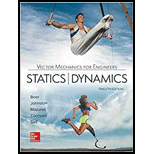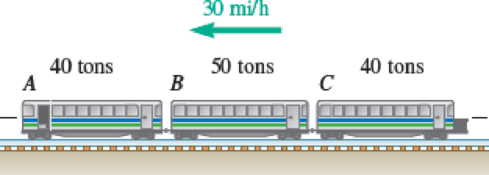
Concept explainers
The subway train shown is traveling at a speed of 30 mi/h when the brakes are fully applied on the wheels of car A, causing it to slide on the track. The brakes are not applied on the wheels of cars B or C. Knowing that the coefficient of kinetic friction is 0.35 between the wheels and the track, determine (a) the time required to bring the train to a stop, (b) the force in each coupling.

(a)
Find the time required to bring the train (t) to a stop.
Answer to Problem 13.130P
The time required to bring the train (t) to a stop is
Explanation of Solution
Given information:
The initial speed of the train
The coefficient of kinetic friction
The weight of the rail car A
The weight of the rail car B
The weight of the rail car C
The acceleration due to gravity (g) is
Calculation:
Show the impulse momentum diagram for the entire train as Figure (1).

Convert the initial speed of the train
Here,
Substitute
Calculate the masses of the rail cars A
Substitute
Calculate the mass of the rail car B
Substitute
Calculate the mass of the rail car C
Substitute
Calculate the frictional force acting on the car B after application of brakes
Substitute
Calculate the frictional force acting on the car C after application of brakes
Substitute
The brakes are not applied on the wheels of car A
Calculate the total mass of the train
Substitute
Calculate the frictional force acting on the car A after application of brakes
Substitute
The brakes are not applied on the wheels of car B and car C, so there is no frictional force acting on the car B and car C, that is
Here,
Calculate the total frictional force acting on the whole train
Substitute
The expression for the impulse acting on the train due to frictional force
Here, t is the time taken by the train to come to rest.
Substitute
Substitute
Therefore, the time required to bring the train (t) to a stop is
(b)
Find the force in each coupling.
Answer to Problem 13.130P
The force in AB
Explanation of Solution
Given information:
The initial speed of the train
The coefficient of kinetic friction
The weight of the rail car A
The weight of the rail car B
The weight of the rail car C
The acceleration due to gravity (g) is
Calculation:
Show the impulse-momentum diagram of rail car A as in Figure (2).

The expression for the impulse acting on the rail car A
Here,
The expression for the principle of impulse-momentum to rail car A alone as follows:
Substitute
Substitute
Show the impulse-momentum diagram of rail car C as in Figure (3).

The expression for the impulse acting on the rail car C
Here,
The expression for principle of impulse-momentum to car C alone as follows:
Substitute
Substitute
Therefore, the force in AB
Want to see more full solutions like this?
Chapter 13 Solutions
VECTOR MECH...,STAT.+DYN.(LL)-W/ACCESS
- In using the bolt cutter shown, a worker applies two forces P to the handles. If the magnitude ofP is 500 N, determine the magnitude of the forces exerted by the cutter on the boltarrow_forwardArterioles bifurcate (i.e., split) into capillaries in the circulatory system. Blood flows at a velocity of 20 cm/s through an arteriole with a diameter of 0.20 cm. This vessel bifurcates into two vessels: one with a diameter of 0.17 cm and a blood flow velocity of 18 cm/sec, and one with a diameter of 0.15 cm. Each of these two vessels splits again. The 0.17-cm diameter vessel splits into two vessels, each with a diameter of 0.15 cm. The 0.15-cm diameter vessel splits into two vessels, each with a diameter of 0.12 cm. Determine the mass flow rate and velocity of blood in each of the four vessels at the end of the arteriole bifurcations. You may need to set up several systems, each with a different system boundary, in order to solve this problem.arrow_forward6) Draw a Front, side and Top view for the following objects: p.s. you don't need to label the alphabet ISOMETRIC PICTORIAL VIEW K R C B E R D 0 Aarrow_forward
- Please draw the front top and side view for the following objectarrow_forwardDraw the top viewarrow_forwardSuppose that a steel of eutectoid composition is cooled to 675°C (1250°F) from 760°C (1400°F) in less than 0.5 s and held at this temperature. (a) How long will it take for the austenite-topearlite reaction to go to 50% completion? To 100% completion? (b) Estimate the hardness of the alloy that has completely transformed to pearlite.arrow_forward
- Problem 2: Determine the components of the reaction at point B (Please use paper sheet + FBD ,don't use chatgpt) MECHANICAL ENGGarrow_forwardARL040_AE_Kn_2of3... Dor Question 4. A two-throw crankshaft has masses distributed as shown: RAH 90 rpm A TRAV B Re Rev M₁ = 15kg; M₂ = 12kg L = 950mm; 1, 350mm; 1₁ = 600mm; 0₁ = 90°; 02=0°; r₁ = 300mm; r250mm The crankshaft is to be balanced by attaching masses at radii of 300 mm and rotating in planes 150 mm outside the planes of number one and number two cranks. Determine the magnitude and angular position of the balance masses. Answer 4.arrow_forwardFEAarrow_forward
 Elements Of ElectromagneticsMechanical EngineeringISBN:9780190698614Author:Sadiku, Matthew N. O.Publisher:Oxford University Press
Elements Of ElectromagneticsMechanical EngineeringISBN:9780190698614Author:Sadiku, Matthew N. O.Publisher:Oxford University Press Mechanics of Materials (10th Edition)Mechanical EngineeringISBN:9780134319650Author:Russell C. HibbelerPublisher:PEARSON
Mechanics of Materials (10th Edition)Mechanical EngineeringISBN:9780134319650Author:Russell C. HibbelerPublisher:PEARSON Thermodynamics: An Engineering ApproachMechanical EngineeringISBN:9781259822674Author:Yunus A. Cengel Dr., Michael A. BolesPublisher:McGraw-Hill Education
Thermodynamics: An Engineering ApproachMechanical EngineeringISBN:9781259822674Author:Yunus A. Cengel Dr., Michael A. BolesPublisher:McGraw-Hill Education Control Systems EngineeringMechanical EngineeringISBN:9781118170519Author:Norman S. NisePublisher:WILEY
Control Systems EngineeringMechanical EngineeringISBN:9781118170519Author:Norman S. NisePublisher:WILEY Mechanics of Materials (MindTap Course List)Mechanical EngineeringISBN:9781337093347Author:Barry J. Goodno, James M. GerePublisher:Cengage Learning
Mechanics of Materials (MindTap Course List)Mechanical EngineeringISBN:9781337093347Author:Barry J. Goodno, James M. GerePublisher:Cengage Learning Engineering Mechanics: StaticsMechanical EngineeringISBN:9781118807330Author:James L. Meriam, L. G. Kraige, J. N. BoltonPublisher:WILEY
Engineering Mechanics: StaticsMechanical EngineeringISBN:9781118807330Author:James L. Meriam, L. G. Kraige, J. N. BoltonPublisher:WILEY





